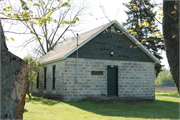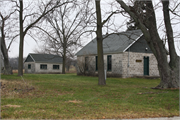Property Record
4207 MORMON RD
Architecture and History Inventory
| Historic Name: | CHURCH OF JESUS CHRIST OF LATTER DAY SAINTS |
|---|---|
| Other Name: | |
| Contributing: | Yes |
| Reference Number: | 221110 |
| Location (Address): | 4207 MORMON RD |
|---|---|
| County: | Racine |
| City: | Burlington |
| Township/Village: | |
| Unincorporated Community: | |
| Town: | |
| Range: | |
| Direction: | |
| Section: | |
| Quarter Section: | |
| Quarter/Quarter Section: |
| Year Built: | 1926 |
|---|---|
| Additions: | |
| Survey Date: | 2011 |
| Historic Use: | house of worship |
| Architectural Style: | Front Gabled |
| Structural System: | Balloon Frame |
| Wall Material: | Concrete |
| Architect: | |
| Other Buildings On Site: | Y |
| Demolished?: | No |
| Demolished Date: |
| National/State Register Listing Name: | Not listed |
|---|---|
| National Register Listing Date: | |
| State Register Listing Date: |
| Additional Information: | In December of 1835, Moses Smith laid the first land claims in the present day City of Burlington. He returned and settled the following spring. The first Mormon congregation in Wisconsin was organized in Burlington by Moses and his brother, Aaron Smith, both of whom had been devout Mormons from around the time of the faith’s founding by Joseph Smith in 1830. Initial meetings were held along the banks of the Fox River. Moses Smith convinced his sister-in-law and her husband, James Jesse Strang, to migrate to Burlington in 1843. Strang was converted to Mormonism the following January. In February of 1844, he traveled to the headquarters of Mormon Church in Nauvoo, Illinois, with Aaron Smith and was baptized there personally by Joseph Smith. Before returning to Burlington, Strang was also made a church elder and was commissioned to form a settlement for persecuted Mormons in Wisconsin with his brothers-in-law, Moses and Aaron Smith. Months later, the Mormon Church was thrown into upheaval after Joseph Smith’s assassination. Strang returned to Nauvoo to present to the church elder’s two claims for his succession as the new leader of the Mormon Church. The first being that at the time of Joseph Smith’s death, Strang claimed an angel appeared to him and appointing him to be the next leader of the Mormon Church. The second was a letter he claimed to have received, postmarked from Nauvoo and purportedly written by Joseph Smith nine days prior to his death, commissioning Strang to lead the church and move all adherents of the faith to the settlement in Wisconsin, to be named “Voree.” Brigham Young, another elder claiming succession to Smith, and other church leaders doubted the authenticity of these claims and ultimately excommunicated Strang from the church. Believing his rightful role as church leader, Strang proceeded to excommunicate Young and gathered Nauvoo Mormons to join him. Young led his followers to resettle at Salt Lake City, Utah, in January 1845, while Strang purchased 200 acres along the White River and established the settlement of Voree there. The name Voree is said to mean “Garden of Peace”. Strang was successful in persuading some of Young’s followers to leave their journey to Utah and join him in Voree, including several relatives of and church leaders close to Joseph Smith. To this day, both Young and Strang divisions consider themselves to be the one true Church of Jesus Christ of Latter Day Saints founded by Joseph Smith, not acknowledging any of the many other Latter Day Saint sects as legitimate. In the fall of 1845, Strang claimed another angelic visitation, this time, telling him to dig beneath a certain oak tree on the nearby “Hill of Promise” to uncover a divine message. Strang and four church elders, Aaron Smith, Jirah B. Wheeler, J. M. Van Ostrand, and Edward Whitcomb, uncovered three copper plates engraved with hieroglyphics which Strang was divinely told only he could translate. According to Strang, the plates, referred to as the Voree Record, had been left there by a prophet and leader of ancient North American inhabitants, named Rajah Manchore of Vorito. The first church meeting at Voree was held in the house of Aaron Smith. However, Strang soon had a revelation commissioning his church to construct a temple at Voree to be the grandest building in the world. It was to cover two-and-a-half acres and have 8-foot-thick stone walls, 12 towers, and a great hall 200-foot square in the center with marble floors and roofs. Referred to as “Strong Tower of Zion,” the structure was to rise imposingly on the summit of the Hill of Promise. The Voree settlers started quarrying limestone north of the hill on the east side of the White River, northwest of the present-day intersection of Mormon and Ridge Roads, to supply stone for the temple’s construction. The temple’s cornerstone was laid in October of 1847. Construction continued slowly due to a lack of money, materials, and skilled builders; only the foundation to the 38-foot square southeast tower, the “Tower of Strength,” was constructed by 1848 and never reached a height of more than one-and a half stories. At its peak, the Mormon settlement at Voree had a population of 300 to 400 inhabitants, which Strang claimed increased to audiences of 1,500. On the west side of the White River were the blacksmith shop of Mr. Werstern, a store operated by a Mr. Stratton, and a village well. A tavern and schoolhouse were built on the east bank. A tithing post was located on Mormon Road, as the community exacted ten percent of all income and agricultural products. By the early twentieth century all of these civic and commercial buildings had become non-extant. During the early 1840s, several modest houses were constructed of the “Voree Quarry” stone along what is now State Highway 11. These belonged to Lemuel Smith, James Strang’s father Deacon Strang, Mr. Werstern, Mr. Whitney, Mr. Bluck, and Josiah Mainwaring. A non-extant road led south from Highway 11, passing the quarry, to what was described as the rather pretentious home of a Mr. Whitcomb. The Werstern, Whitney, Bluck, Mainwaring, and Whitcomb Houses were all non-extant by the early twentieth century. However, due to the settlers’ generally small financial means and the fast rate of their migration, the majority of residences in Voree were crude log cabins, wooden sheds, or tents. Nearby farmhouses were crowded by the incoming settlers. James Strang did not have a house of his own until 1846 when he received a divine revelation that faithful followers should build one for him. Now non-extant, it was a one-room log cabin located on the west bank of the White River near his father’s house which had been constructed in 1844. A Mr. Montgomery constructed a stone house nearby on Mormon Road in 1848. From his father’s house, Strang began publishing a weekly paper called the Voree Herald in January of 1846 with a printing press acquired from Philadelphia. In November of that year, the name was changed to Zion’s Reveille, and finally to The Gospel Herald in September of 1847. Considered the first newspaper in the region, Strang published legal notices such as mortgage sales, attachments, and deeds for the Burlington area in addition to Mormon literature used in proselytizing throughout the country. Also in 1846, Strang began searching for a new and more isolated home for his following. The following year he said it had been revealed to him in a vision that they should relocate the community to Big Beaver Island at the northern tip of Lake Michigan, near Mackinac, Michigan. As the island had not yet been opened for settlement, Strang was granted permission by the federal government to operate an Indian mission there in 1847. He began publishing a newspaper there known as The Northern Islander promoting life in what he described as the “New Zion.” While many stayed at Voree and other Mormon settlements across the country, more than 1,500 people migrated to St. James during the following two years. In 1850, Strang received a divine command to establish an ecclesiastical monarchy. On July 8th of that year, Strang was crowned king of his church. Also that year, Strang began practicing polygamy. While members of the Young’s church in Utah had been employing the practice before that time, Strang was the first Mormon leader to publicly embrace the doctrine of polygamy, marrying four additional wives named Elvira, Betsy, Sarah, and Phoebe. Strang was shot by two disenchanted followers in the summer of 1856. He was brought back to Voree accompanied by his four wives, died 10 days later, and was buried in the Voree cemetery. At some point in time, his remains were reinterred at Burlington Cemetery. After Strang left Big Beaver Island, his church fled as their settlement was destroyed by angered mainlanders. After Strang’s death, the Voree land was foreclosed upon and the uncompleted temple structure was torn down. The remaining Strangite Latter Day Saints in Voree reorganized in 1857, using the non-extant, cobblestone Voree schoolhouse to house meetings. A loyal Strangite, Wingfield Watson, repurchased 105 acres of the land in hopes that other Strangites might resettle at Voree. At his death in 1922, Watson left his property to a trust. In 1926, a new church building was constructed of concrete block on a portion of this land at 4207 Mormon Road. By 1930, membership in the Strangite division of the Mormon Church was estimated at as low as 4 members. In 1935, a memorial of stone from the Voree Quarry was constructed at the south side of Highway 11 at the White River in honor of the history of Voree in conjunction with the City of Burlington’s 100th anniversary. The monument displays a plaque made by internationally renowned sculptor Nancy Coonsman Hahn on each side, one sponsored by the Burlington Historical Society containing a map created that year depicting the location of the old Voree landmarks and the reverse side hosting a memorial plaque to James Jesse Strang sponsored by remaining church members. The memorial site was leased to the historical society by the Watson trust and was maintained as a park for several years by the church members. In 1974, membership was estimated at 15, and increased to between 50 and 200 members by the mid-1990s, located mainly in Wisconsin, Michigan, Colorado, and New Mexico. By that time, only two public meeting places were in existence locally, the headquarters and church on Mormon Road and another in the nearby Town of Lyon. |
|---|---|
| Bibliographic References: | General Files. On file at the Burlington Historical Society, Burlington, Wisconsin. |
| Wisconsin Architecture and History Inventory, State Historic Preservation Office, Wisconsin Historical Society, Madison, Wisconsin |


